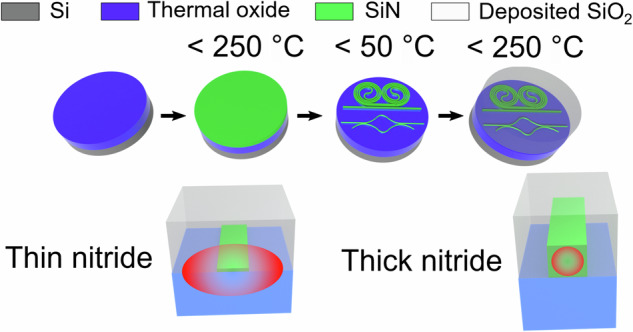- Record: found
- Abstract: found
- Article: found
Anneal-free ultra-low loss silicon nitride integrated photonics

Read this article at
Abstract
Heterogeneous and monolithic integration of the versatile low-loss silicon nitride platform with low-temperature materials such as silicon electronics and photonics, III–V compound semiconductors, lithium niobate, organics, and glasses has been inhibited by the need for high-temperature annealing as well as the need for different process flows for thin and thick waveguides. New techniques are needed to maintain the state-of-the-art losses, nonlinear properties, and CMOS-compatible processes while enabling this next generation of 3D silicon nitride integration. We report a significant advance in silicon nitride integrated photonics, demonstrating the lowest losses to date for an anneal-free process at a maximum temperature 250 °C, with the same deuterated silane based fabrication flow, for nitride and oxide, for an order of magnitude range in nitride thickness without requiring stress mitigation or polishing. We report record low anneal-free losses for both nitride core and oxide cladding, enabling 1.77 dB m -1 loss and 14.9 million Q for 80 nm nitride core waveguides, more than half an order magnitude lower loss than previously reported sub 300 °C process. For 800 nm-thick nitride, we achieve as good as 8.66 dB m −1 loss and 4.03 million Q, the highest reported Q for a low temperature processed resonator with equivalent device area, with a median of loss and Q of 13.9 dB m −1 and 2.59 million each respectively. We demonstrate laser stabilization with over 4 orders of magnitude frequency noise reduction using a thin nitride reference cavity, and using a thick nitride micro-resonator we demonstrate OPO, over two octave supercontinuum generation, and four-wave mixing and parametric gain with the lowest reported optical parametric oscillation threshold per unit resonator length. These results represent a significant step towards a uniform ultra-low loss silicon nitride homogeneous and heterogeneous platform for both thin and thick waveguides capable of linear and nonlinear photonic circuits and integration with low-temperature materials and processes.
Abstract
We demonstrate for the first time, a uniform low temperature (<250 °C) process for fabricating both high-confinement thick and low-confinement thin ultra-low loss Silicon nitride waveguides.

Related collections
Most cited references79
- Record: found
- Abstract: not found
- Article: not found
Dissipative Kerr solitons in optical microresonators
- Record: found
- Abstract: not found
- Article: not found